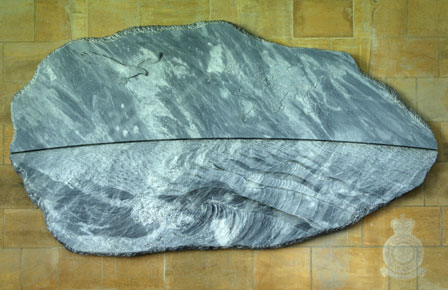Although our individual practices are different, we were able to combine our relief carving and drawing skills. It was felt that a design that would encompass significant and meaningful elements relating to real experience would be better held in the imagination of the general public and aircrew, rather than a traditional memorial. It was through our discussions with Air Chief Marshal Sir John Barraclough, one of the wartime pilots, that we realised the significance of the horizon to an airman, not only as a guide, but also as a symbol of loss and death.
The focus of our design became a precise curved horizon line, made by the meeting of two pieces of Bardiglio marble with a small shadowed recess. The two stones are carved to represent the sea and the sky. The carving was carried out by Neil Talbot and the natural pattern in the stone, which grades from dark blue/grey to white, has been used to represent cloud in the upper stone, and foam and spray in the carving of the sea. An eagle in the upper part surveys the waves and represents the Air Force, and a lightly carved map of the world symbolises global operations. People have since remarked on its mystical and atmospheric qualities. The carving of the sea places the viewer above the waves, and represents it in all its moods
Anna Talbot helped with the carving, and the inscription was commissioned separately and was designed by Richard Kindersley. John Maine and Sir Philip Dowson also advised on the project.
